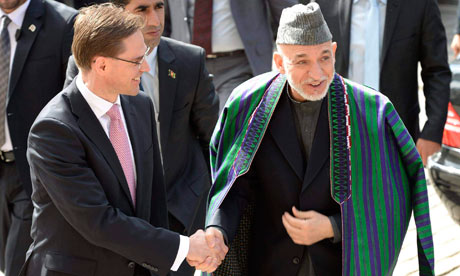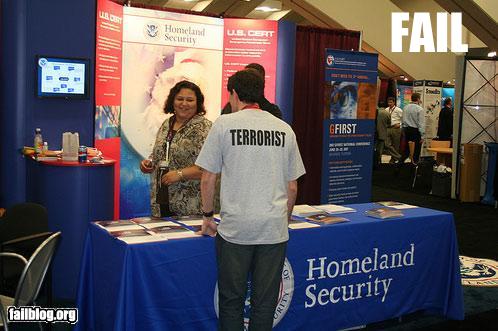Militia Hired by State Dept. Warned It Wouldn’t Protect Stevens’ Movements in Benghazi
May 1, 2013

In
a photo published in the December 2011 edition of State Magazine, the
State Department's in-house publication, a diplomatic security officer
in Benghazi trains local Libyan guards in marksmanship. (State
Department photo)
(CNSNews.com) - The February 17th Martyrs Brigade, a Benghazi-based
militia with Islamist elements that the State Department hired as a
“quick reaction force” (QRF) to protect the department’s mission in
Benghazi, warned the State Department that it would not protect the
movements of Amb. Chris Stevens when he visited there last September.
That warning was relayed to the regional security officer (RSO) at
the U.S. Embassy in Tripoli--the top security adviser to the
ambassador--in an internal State Department email dated Sept. 9, 2012.
That was one day before Stevens departed Tripoli for Benghazi--for what was scheduled to be a five-day visit.
“[O]n September 8, 2012, just days before Ambassador Stevens arrived
in Benghazi, the February 17 Martyrs Brigade told State Department
officials that the group would no longer support U.S. movements in the
city, including the Ambassador’s visit,” said a report on Benghazi
released last week by the chairmen of the House Foreign Affairs,
Intelligence, Oversight, Judiciary and Armed Services committees.
In a footnote, the report attributed this information to an “Email
from Alec Henderson to John B. Martinec, ‘RE: Benghazi QRF agreement,’
(Sep. 9, 2012 11:31 PM).”
The fact that the militia gave the State Department prior warning
that it would not support the ambassador’s movements in Benghazi raises
new questions about the way the department handled security in
Benghazi and its subsequent unwillingness to make department personnel
available to congressional committees that are investigating the Sept.
11, 2012 terrorist attack.
The State Department’s Accountability Review Board (ARB) report,
released on Dec. 18, had revealed that the February 17 militia was no
longer protecting the movement of U.S. vehicles in Benghazi at the time
of Stevens’ September visit to the city. But it did not say that this
information had been delivered to the regional security officer in
Tripoli the day before Stevens traveled to Benghazi.

In
this photo published in State Magazine, the State Department's in-house
publication, then-Special Envoy Chris Stevens in 2011 tours the ruins
of the ancient Byzantine city of Cyrene in Libya, protected by State
Department Diplomatic Security officers. (State Department photo)
“At
the time of Ambassador Stevens’ visit, February 17 militia members had
stopped accompanying Special Mission vehicle movements in protest over
salary and working hours,” said the ARB report.
A Senate Homeland Security Committee report issued on Dec. 30 also
included some additional details the ARB report had not. It said: “In
early September, a member of the February 17 Brigade told another RSO
[State Department regional security officer] in Benghazi that it could
no longer support U.S. personnel movements. The RSO also asked
specifically if the militia could provide additional support for the
Ambassador’s pending visit and was told no.”
A footnote in the Senate committee report attributes this information
to an email sent to Charlene Lamb, who was then the deputy assistant
secretary of state responsible for diplomatic security. The email was
sent Sept. 20, 2012--nine days after the Sept. 11, 2012 terrorist attack
in Benghazi. The footnote says: “REDACTED, e-mail message to Charlene
Lamb, ‘Ambassador’s protective detail in Benghazi,’ September 20,
2012.”
Back on Oct. 10, 2012, when the House Oversight and Government Reform
Committee held an initial hearing on the Benghazi terrorist attack, it
took testimony from Lamb and from Eric Nordstrom. Nordstrom had served
as the RSO in Tripoli, but left Libya on July 26, 2012, when he was
replaced as RSO by Martinec--more than six weeks before the Sept. 11,
2012 Benghazi attack.
Martinec was the RSO in Tripoli, and thus Amb. Stevens' top security
adviser, in the weeks leading up to the Sept. 11, 2012 terrorist attack
in Benghazi. He was the RSO who received the internal Sept. 9 State
Department email stating that the February 17 militia had warned that
it would no longer support the movements of U.S. personnel in
Benghazi--including the movements of Amb. Stevens. Martinec was also the
RSO at the U.S. Embassy in Libya when the Benghazi attack occurred.
But--unlike Nordstrom, who did not get the warning from the February
17 militia and who was not the RSO at the U.S. Embassy in Libya when the
Benghazi attack occurred--Martinec did not testify in the House
Oversight and Government Reform Committee.
Nor did the committee take testimony from the as-yet-anonymous RSO
who was on temporary duty in Benghazi in September 2012 and, who,
according to the Senate Homeland Security Committee report, heard
directly from the February 17 militia that it would no longer support
U.S. movements in the city.
The State Department’s Accountability Review Board concluded that the
number of State Department security people on the ground in Benghazi
had been inadequate even in the period that preceded the February 17
militia’s declaration that it would no longer protect the movements of
U.S. personnel in the city.
“Overall, the number of Bureau of Diplomatic Security (DS) security
staff in Benghazi on the day of the attack and in the months and weeks
leading up to it was inadequate, despite repeated requests from Special
Mission Benghazi and Embassy Tripoli for additional staffing,” said the
ARB report.
Not only was the State Department facility in Benghazi understaffed,
according to the ARB, it was also staffed with less experienced
officers.
“Furthermore, DS’s reliance on volunteers for TDY [temporary duty]
positions meant that the ARSOs [assistant regional security officers] in
Benghazi often had relatively little or no prior DS program management
or overseas experience,” said the ARB report. “For a time, more
experienced RSOs were sent out on longer term TDYs, but even that
appeared to diminish after June 2012, exactly at the time the security
environment in Benghazi was deteriorating further.”
Both the ARB report and the Senate Homeland Security Committee report
concluded that the Americans on the ground in Benghazi during the
terror attack, including the State Department security officers, acted
with great courage.
“The board determined that U.S. personnel on the ground in Benghazi
performed with courage and readiness to risk their lives to protect
their colleagues, in a near impossible situation," said the ARB report.
"While our country spent Sept. 11, 2012, remembering the terrorist
attacks that took place 11 years earlier, brave Americans posted at U.S.
government facilities in Benghazi, Libya, were fighting for their
lives against a terrorist assault," said the Senate Homeland Security
Committee report.
On Sept. 10, 2012—the day after RSO John Martinec at the Tripoli
embassy got the email telling him that the February 17 militia would
not support the ambassador’s movements in Benghazi—there were only
three temporary duty State Department Diplomatic Security officers
deployed at the department’s compound in that city. Stevens brought
only two more with him when he went ahead with his trip to Benghazi
that day—bringing the total number of State Department security
personnel in that city to five.
The ARB report “found that plans for the Ambassador’s trip provided
for minimal close protection security support, and that Embassy country
team members were not fully aware of planned movements off compound.”
By the ARB’s accounting, the five State Department security officers
with Amb. Stevens on Sept. 11 were outnumbered within the State
Department’s own compound by the eight hired Libyan “guards” there that
day. These included three of the four February 17 militia, who lived
within the compound, and five unarmed contract guards working for the
Blue Mountain Libya contractor.
“In the absence of an effective central government security presence,
the Special Mission’s Libyan security contingent was composed of four
armed members of the February 17 Martyrs’ Brigade (February 17)--a
local umbrella organization of militias dominant in Benghazi (some of
which were Islamist) and loosely affiliated with the Libyan government,
but not under its control,” said the ARB report. “They resided in a
guest house building on compound. Normally four members resided on the
Special Mission compound near the front gate, but on September 11 one
had been absent for several days, reportedly due to a family illness.
The Special Mission also had an unarmed, contract local guard force
(LGF), Blue Mountain Libya (BML), which provided five guards per
eight-hour shift, 24/7, to open and close the gates, patrol the
compound, and give warning in case of an attack.”
Two weeks before Amb. Stevens traveled to Benghazi, the diplomatic
officer who was then manning the mission on temporary duty wrote an
email to the diplomatic officer coming in to replace him. The email gave
his view of the February 17 militia.
“In a handoff email to his replacement on August 29, 2012, the
principal U.S. diplomatic officer in Benghazi wrote that the contract
with the militia ‘lapsed several weeks ago’ but that they were still
operating under its terms,” said the Senate Homeland Security
Committee’s December report. “He said that ‘[t]his is a delicate issue,
as we are relying on a militia in lieu of the central authorities and
[Feb 17 Brigade] has been implicated in several of the recent
detentions. We also have the usual concerns re their ultimate loyalties.
But they are competent, and give us an added measure of security. For
the time being, I don’t think we have a viable alternative.’”
In other words, the only "viable alternative" the State Department
found for enhancing its security in Benghazi beyond the three American
diplomatic security agents it had temporarily posted there was a militia
implicated in detaining people, whose loyalty was in doubt, and that
had just warned the State Department that it would not protect the
movements of Amb. Stevens when he visited Benghazi for a five-day period
spanning the eleventh anniversary of the Sept. 11, 2001 terrorist
attacks.
So, in the face of that warning, why did Amb. Stevens go ahead and
travel to Benghazi on Sept. 10? Why did he bring along only two
additional security officers?
At the Oct. 10 hearing of the House Oversight and Government Reform
Committee, former Tripoli RSO Nordstrom described Stevens as an
ambassador who listened to and followed the advice of his security team.
“I asked you about Ambassador Stevens, a very skilled career diplomat
and how he dealt with threats related to security,” Chairman Darrell
Issa (R.-Calif.) said to Nordstrom. “And you told me, I'm paraphrasing,
that, for example, when there was a perceived threat in his running, he
ceased running. Then when both you and Colonel [Andrew] Wood [who
commanded a military Site Security Team that had been previously been
stationed at the Tripoli embassy] were able to come up with an
acceptable way that he could continue by varying where he went and so
on. He ran again, but only ran again under your authority and your
recommendation. Is that correct?”
“That's correct, chairman,” said Nordstrom.
“And I think I asked you, was he a compliant officer?” asked Issa.
“Did he do what you thought when you recommended it or did he chafe at
any time over what you thought was best for his security?”
“At no time did I have any concerns raised to me by Ambassador Stevens,” said Nordstrom.
On Sept. 10, his first day in Benghazi, according to the ARB report,
Stevens traveled to at least two locations in the city: the CIA Annex
that was down the road from the State Department compound and a hotel
where he had dinner with the city council.
The next day, the eleventh anniversary of the 2001 terrorist attacks,
he did not leave the State Department compound. “Ambassador Stevens
and Benghazi-based DS agents had taken the anniversary into account and
decided to hold all meetings on-compound on September 11,” said the
ARB report.
The terrorist attack on the compound started at about 9:42 p.m.
Benghazi time. The ARB report concluded that as it unfolded the February
17 militia did not perform well.
“The Board’s inquiry found little evidence that the armed February 17
guards alerted Americans at the SMC [Special Mission Compound] to the
attack or summoned a February 17 militia presence to assist
expeditiously once the attack was in progress--despite the fact that
February 17 members were paid to provide interior security and a quick
reaction force for the SMC and the fact that February 17 barracks were
in the close vicinity, less than 2 km away from the SMC,” said the ARB
report.
In a Nov. 2 story, the Wall Street Journal reported that:“The CIA's
security force at the annex sometimes provided backup security for the
ambassador when he traveled outside the consulate.” This report was
cited by the Congressional Research Service in a report of its own when
it said CIA “[p]ersonnel in Benghazi reportedly included a security
force of approximately 10 individuals, who had on previous occasions
shielded Ambassador Stevens when he left the U.S. facility.” (Note:
Stevens had served as a special envoy to the Libyan revolutionaries in
Benghazi from April 5, 2011 until Nov. 17, 2011. But he had left Libya
after that, and his September 2012 trip to Benghazi was his first to
that city since he had returned to Libya on May 26, 2012 to serve as
U.S. ambassador.)
Asked by CNSNews.com whether CIA security personnel assisted in
providing security for Stevens when he travelled around Benghazi on
Sept. 10, or planned to assist in securing Stevens’ later movements in
Benghazi on that trip, the CIA declined to comment.
In January, the House Oversight committee told CNSNews.com that the
State Department had not up to that point given the committee access to
the Diplomatic Security agents who were in Benghazi on Sept. 11, 2012.
This week, neither the State Department, nor the House Oversight,
Foreign Affairs or Intelligence committees responded to questions about
whether the committees, since January, had been given access to
Diplomatic Security officers who were in Libya during the Benghazi
attack.
At a White House press conference on Tuesday, Ed Henry of Fox News
asked President Obama: “There are people in your own State Department
saying they’ve been blocked from coming forward, that they survived the
terror attack and they want to tell their story. Will you help them
come forward and just say it once and for all?”
Obama responded: “I’m not familiar with this notion that anybody has
been blocked from testifying. So what I’ll do is I will find out what
exactly you’re referring to.”
Later on Tuesday, House Oversight Chairman Darrell Issa responded to the president.
“A lawyer for Benghazi whistleblowers [Victoria Toensing, who was
chief counsel for Sen. Barry Goldwater when he was chairman of the
Senate Intelligence committee] has publicly stated that the State
Department is blocking her client’s ability to talk freely with
counsel,” said Issa. “Over the past two weeks, I have sent four letters
requesting that this Administration make information available about
how lawyers--who already have security clearances and are representing
Benghazi whistleblowers--can be cleared to fully hear their clients’
stories. I have yet to receive any response from the Obama
Administration.
“Even if the President really doesn’t know anything about someone
wanting to come forward, his position should be that whistleblowers
deserve protection and that anyone who has different information about
Benghazi is free to come forward to Congress,” said Issa. “The
President’s unwillingness to commit himself to protecting whistleblowers
only aids those in his Administration who are intimidating them.”

 According to an
According to an 
 Keith's note:
What did we learn from this, Rep. Wolf? Porn is being exported to China
on NASA laptops. Apparently the porn in question was unclassified.
Keith's note:
What did we learn from this, Rep. Wolf? Porn is being exported to China
on NASA laptops. Apparently the porn in question was unclassified.







